As the new year begins, one’s thoughts turn to renewal and the cyclical nature of time. However, I’m not going to bore you all with my ruminations on the nature of being and time. Instead, I thought I might try to illustrate renewal through a life-cycle entry. And, as luck would have it, I was able to document nearly the entire life cycle of a beneficial insect, the Asian multicolored lady beetle, on the first day of January, 2015 (although it took a few more days to get a real shot of the 3rd stage, the pupa).
There are many different species of lady beetles: over 6000 worldwide; over 450 in North America; here in Florida there are over 100 species. One of the most common is the Asian multicolored lady beetle, Harmonia axyridis. It was introduced into North America several times for the purpose of biological control of insect pests: in California in the 1960s and again in the Eastern states between 1978 and 1982. None of these introductions appears to have been successful, but an accidental introduction near New Orleans in 1988 did the trick, and now this species is widespread and abundant.
It displays the familiar field marks of the typical ladybug: rounded body plan with a polka-dotted red “shell” (the hardened wing covers called elytra). The number of spots is variable, but this individual is fairly typical of the species, with four large dots at the “top of the dome” and about 14 other spots in pairs around the base:
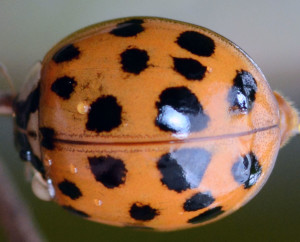
It also has two large white dots on the “shoulders”:
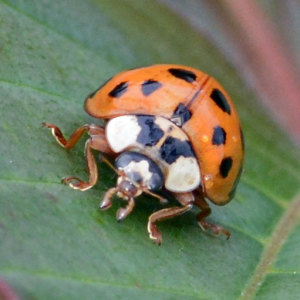
You can also see the large mandibles in the shot above; they are employed in service to these beetles’ hunger for horticultural pests like aphids and scale insects and mealy bugs. This appetite makes this exotic species not entirely unwelcome even in the garden of a native plant enthusiast like me, to whom imported species are normally anathema.
When it’s ready to reproduce, it lays its eggs in clusters. In the first image below, you can count 13 eggs; in the second, there are 14. So just in case there was any doubt, this lady bug truly is a lady:
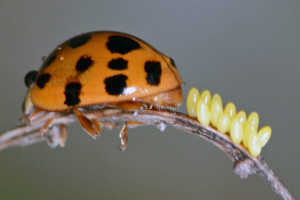
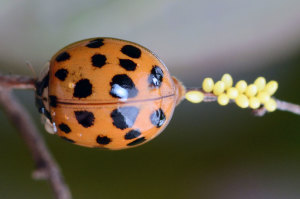
Once the female is done laying eggs, she flies the coop (mouse over the image to see the fun):
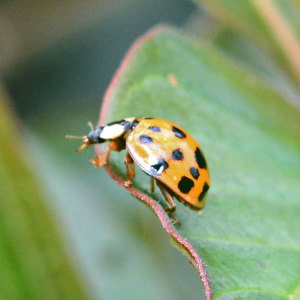
Later, the eggs hatch, and the rather alarming-looking spiky larvae start to roam the surface of the plant looking for food. Below is a last instar larva, probably ready to pupate in the next day or two:
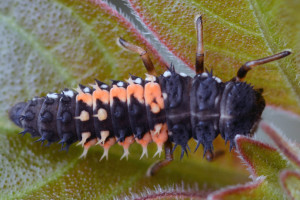
It took a while to get any shots of a pupa; below is a larva that is just sloughing off its last larval skin and getting ready to pupate:
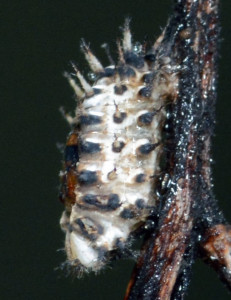
And here is a pupal lady beetle, presumably Asian multicolored although I’m not certain:
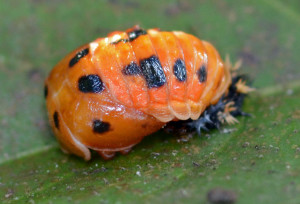
Etymology: uncertain. The name was invented by Pallas in 1773. Harmonia is, of course, a “fitting together,” harmony. But the meaning of a-xyridis escapes me. I’ve seen on the web that it is the generic name of Russian pigweed (Axyris amaranthoides), but I’m not certain that solves the issue for me. After all, what does axyris mean? I haven’t been able to find out.
References
Eaton, E. R. and K. Kaufman. 2007. Field Guide to Insects of North America. New York: Houghton Mifflin.
Frank, J. H. and Mizell, R. F. Ladybirds, Ladybird beetles, Lady Beetles, Ladybugs of Florida, Coleoptera: Coccinellidae. EENY170/IN1327. Available at http://edis.ifas.ufl.edu/in327.
Mizell, R. F. Featured Creatures: common name: multicolored Asian lady beetle. scientific name: Harmonia axyridis Pallas (Insecta: Coleoptera: Coccinellidae). EENY204. Available at http://entnemdept.ufl.edu/creatures/beneficial/multicolored_asian_lady_beetle.htm.

This was great. Thanks so much! My plum tree was covered with aphids, and then it was covered with Ladybug larvae. I wasn’t sure what they were, but now I am, thanks to your excellent photos!